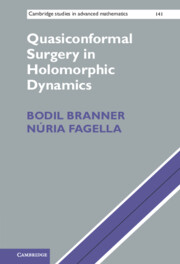Book contents
- Frontmatter
- Dedication
- Contents
- List of contributors
- Preface
- Acknowledgements
- List of symbols
- Introduction
- 1 Quasiconformal geometry
- 2 Boundary behaviour of quasiconformal maps: extensions and interpolations
- 3 Preliminaries on dynamical systems and actions of Kleinian groups
- 4 Introduction to surgery and first occurrences
- 5 General principles of surgery
- 6 Soft surgeries
- 7 Cut and paste surgeries
- 8 Cut and paste surgeries with sectors
- 9 Trans-quasiconformal surgery
- References
- Index
5 - General principles of surgery
Published online by Cambridge University Press: 05 February 2014
- Frontmatter
- Dedication
- Contents
- List of contributors
- Preface
- Acknowledgements
- List of symbols
- Introduction
- 1 Quasiconformal geometry
- 2 Boundary behaviour of quasiconformal maps: extensions and interpolations
- 3 Preliminaries on dynamical systems and actions of Kleinian groups
- 4 Introduction to surgery and first occurrences
- 5 General principles of surgery
- 6 Soft surgeries
- 7 Cut and paste surgeries
- 8 Cut and paste surgeries with sectors
- 9 Trans-quasiconformal surgery
- References
- Index
Summary
The previous chapters contain examples of quasiregular maps for which an invariant almost complex structure with bounded dilatation exists. It is a natural question to ask under which conditions this can be accomplished, so that a holomorphic dynamical copy is obtained by means of the Integrability Theorem.
We first present two statements, both due to Shishikura, describing typical scenarios in surgery constructions. The first one was called the Fundamental Lemma of Quasiconformal Surgery in [Sh1]. It applies to most procedures of cut and paste surgery, where we paste together holomorphic and quasiregular mappings. This is the case, for example, in Section 4.2, where we glue a Blaschke product into a basin of attraction. Shishikura stated his principle for rational maps. We include more general types and slightly modify one of the hypotheses. The second principle may be viewed, in some cases but not all, as a particular case of the first.
Finally, we present Sullivan's Straightening Theorem, also called the Generalized Shishikura Principle, which is the strongest of the three. It gives a necessary and sufficient condition for a quasiregular map f to admit an invariant almost complex structure. Namely, it requires the iterates fn to be uniformly K-quasiregular for some K < ∞. Although the Shishikura principles follow from this theorem, we choose to prove them independently, since the proof illustrates a procedure we shall use in many of the surgeries to come.
- Type
- Chapter
- Information
- Quasiconformal Surgery in Holomorphic Dynamics , pp. 179 - 187Publisher: Cambridge University PressPrint publication year: 2014

